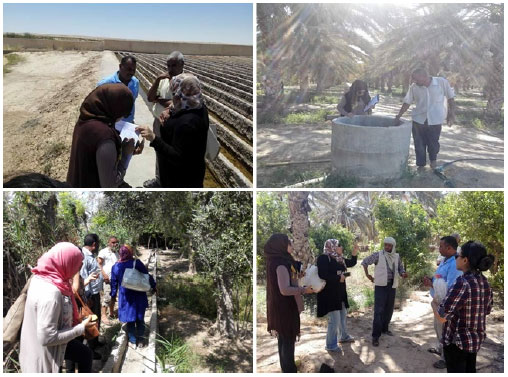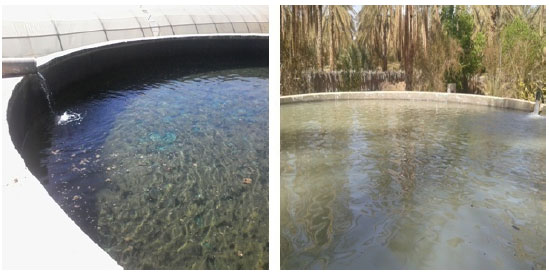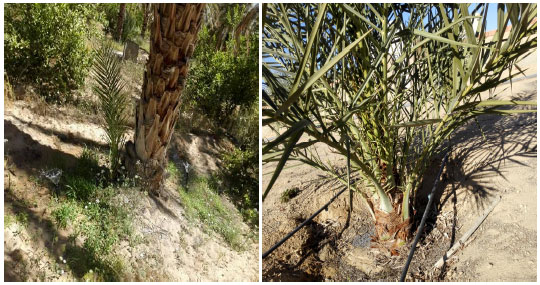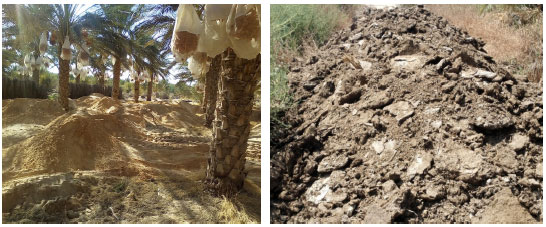Agricultural Journal
Local Adaptations under Tunisian Oasis Climatic Conditions: Characterization of the Best Practices in Water Agricultural Sector
Authors : L. Dhaouadi, N. Karbout, K. Zammel, M.A.S. Wahba and S. Abdeyem
Abstract: For a long time, the governance of water resources in oases presents great challenges for local and national stakeholders with the consideration of economic, social and environmental importance of this complex ecosystem. So, it’s very important to understand its behavior under current and future climate change conditions. This study focuses on diagnosing, identifying, characterizing and capitalizing the most practices of irrigation water management in the Tunisian oasis and selecting the best among them and to disseminate it in the oasis communities through workshops, field days and school days. The most capitalized best practices found during this study are: community governance of irrigation water distribution in the oases of El Guetar, valorization of the oasis heritage through the labialization SIPAM (case of the historic Oases of Gafsa), Improved gravity irrigation Basin system under date palm in the Oases, the sandy amendment at the level of oasis agricultural parcels, gravity Bubbler irrigation system in date palm groves and magnetic treatment of irrigation water and mixing of irrigation waters to improve their qualities.
How to cite this article:
L. Dhaouadi, N. Karbout, K. Zammel, M.A.S. Wahba and S. Abdeyem, 2020. Local Adaptations under Tunisian Oasis Climatic Conditions: Characterization of the Best Practices in Water Agricultural Sector. Agricultural Journal, 15: 57-64.
INTRODUCTION
In the arid and semi-arid areas, agriculture has concentrated in regions where water is available. The Oasis agrosystem is an intensive man-made farming system associated with the cultivation system in arid and semi-arid areas. Oasis are mainly found near underground aquifers where water can reach the surface naturally and can be extracted through pumping. For a long time, Oasis agrosystems have played an important role in the development of the arid areas and the settlement of humans in these areas through providing various ecosystem services such as supplying food and fodder, managing available natural resources such as water and soil as well as enhancing biodiversity under local climate condition[1]. Additionally, Oasis agrosystems can help to mitigate the negative effects of climate change in dryland areas, they are seen as the opposite to desertification and land degradation and thus, they have the potential to contribute to carbon sequestration in the arid areas[2, 3].
In Tunisia, Oases date back to ancient times and the survival of these agrosystems was a result of the adapted traditional management practices of the people living at the oases. Traditional oases for instance have a significant role in terms of economic growth not only for the country through date’s production but also for the rural towns and communities, they create jobs and support biodiversity. Different studies have highlighted the socio-economic importance of the oasis agrosystem for the economic growth of the rural communities as well as for the state economy[4].
Oases cover a total area of 40803 ha; they stretch from the Mediterranean coast in the east to the Grand Erg Oriental in the West and from Gafsa Mountain in the North to Sahara in the South of the country. Geographically Tunisian Oases are classified into two origin categories based on the typology of the Oasis, the coastal Oasis which cover 17% of the Oases total area and the continental Oasis which cover 83% of the Oases total area and produce more than 89% of date production in the country (dominated by DegletNour variety). The continental oases are divided into Saharan Oasis and mountain Oasis. Saharan Oasis are located in the northern Tozeur region and scattered around Chott El-Jerid in Kebili Governorate[5]. Most of the mountain Oasis are concentrated in Gafsa region and cover 2, 38 ha (6% of Oases total area).
Tunisian Oasis are facing a number of threats such as low productivity, deterioration of water resources, soil salinization and increased pests and diseases associated with biodiversity loss[6]. These threats are coupled with land mismanagement practices such as over exploitation of natural resources, especially, water which affects the Oasis agrosystem survival and therefore their role in maintaining the livelihoods of the local inhabitants. In Tunisian Oasis, ground water is the the main source of irrigation water. The underground water that supply southern Oases comes from two of the largest aquifers in the world, the Terminal Complex aquifer, a small part of which is under Tunisia and the Continental Interlayer. In the South is the Jeffara aquifer that fed mainly from overspill from the Terminal Complex aquifer extends under the Jeffara coastal plain between Gabes and Zarzis. Others, much smaller aquifers also exist in these regions that are recharged from drainage water in Oases and from flooding in small wadis. Water management of irrigation water is carried out by Collective Interest Association (AIC) and the water distribution is made based on the irrigation schedule decided by AIC with the assistance of Regional Commissariat for Agricultural Development CRDA. In Tunisian southern Oases date palm groves are irrigated through the surface irrigation system. Farrow and basin techniques are considered as modified forms of flood technique in which water is directed to flow through narrow channels established between palm trees rows. While this method is less expensive and easy managed in flatted lands nevertheless, the technique suitability in sandy soils is rather low due to high loss of water through leaching and evaporation. The depletion of water resources is clearly a major problem in the Southern Oases of Tunisia, the so, called illegal extension of Oases as a result of private initiatives and access to water through digging wells has led to over-extraction of renewable ground water and accelerating phenomenon of saline intrusion from the saline areas (e.g., Chott Djerid in Kebili)[7]. In addition, most of the farmers managed the water in their own way in the absence of a specific recommended method which leads to considerable water loss[8]. So, the continuous decline in water availability will affect the region through increasing land vulnerability to desertification and bring the agriculture at risk. Water problems in Oasis are expected to surge by the climate change impacts through extensive drought events[9]. Tunisian Oasis are expected in the influence of a warming of 1.1°C by 2030 and 2.1° C by 2050[10]. Date production is expected to be severely affected as a result of this change; the areas where date palm grows may become unsuitable to support an economic production of the crop[11]. Climate change is predicted to reduce the growing period of the plants and thus date cultivation is subjected to change to attain higher crop production, farmers are thus need to consider tolerant varieties to drought and best management practices to adapt to these effects[12].
Since, groundwater is the major source of water in Oasis, the overuse of this water under arid and semi-arid conditions is a serious problem for the long term agricultural sustainability in these unique areas. It needs integrated management strategies for the safe use of all available water resource including drainage water, brackish ground water. Wahba[13] studied different strategies for using agricultural drainage water for irrigation over a 20-year period using simulation modeling and recommended the strategies of deficit irrigation combined with controlled drainage, cyclic use of agricultural drainage water of 4-12 dS m–1 with fresh water and the inter-seasonal cycling of drainage and fresh water. In this context this study is to diagnosing, identifying, characterizing and capitalizing the most practices of irrigation water management in Tunisia oasis and selecting the best among them and to disseminate it in the oasis communities through workshops, field days, and school days.
MATERIALS AND METHODS
Site description: The study was conducted at South Tunisian Oases (Fig. 1), coastal Oases in Gabes, continental Oases in Kebili and Tozeur and mountain Oases in Gafsa. Coastal Oases stretch along the coast of Gulf of Gabes in the south east of the country. Whereas continental Oases is located in Kebili and Tozeur region South-West Tunisia, the Oasis location is to the west and adjacent to Chott Djerid (a salt plain) and mountain oases located in Gafsa region in the Southwest of Tunisia. Costal Oases climate is Mediterranean dry, hot in summer and mild in winter. Rainfall is low and erratic with an annual average of 186 mm. Under the influence of Saharan winds, the summer temperature can reach 42.5°C in August and falls to reach 5°C in winter in December and January. The winds blow between December and April are cold, dry and carrying sand. The soils of the Oasis are gypsum calcareous, according to WRB classification; it can be classified as Gypsisol. On the surface there are several meters of sand gypsum limestone which forms crust gypsum layer. The soil of the Oasis is alkalized (pH 7.22-8.68)[14]. Continental Oases are characterized by a desert climate, the annual precipitation is irregular and <90 mm and the temperature is very high during the summer (maximum 55°C in July). Evaporation can reach 2000 mm per year. In the spring and summer seasons, the strong hot winds of sirocco blow carrying sands from the desert into the Oasis. The continental oases are classified as Gypsisols according to WRB. The sandy soils of the Oasis are characterized by high permeability and low water retention. Groundwater and soil salinity varies with water table depth. Mountain Gafsa oases are characterized by desert climate, the annual precipitation reached a maximum of 203 mm; the summer temperature can achieve a maximum of 30.5°C in July and falls to reach 11°C in winter (January). The mountain oases are classified as calcareous soil according to WRB.
Data collection tools and field campaign: The study has targeted about 55 agriculture, 13 from Tozeur Oases, 14 from Gafsa oases, 18 from Kebili Oases and 10 from Gabes Oases, to fill the individual questionnaires 55 respondents were interviewed in March, 2018. Before starting with the individual interviews, we collected data using the documents available from the Regional Development Commissariat (RDCA) and the Regional Research Center for Oasis Agriculture (RROA) to retrieve information about the Oasis conditions, based on the data collected on formulating the questions of the individual questionnaire, i.e., completing the different agriculture practices to reduce water losses in Oases systems. Due to homogenous characteristics of the farmers, a simple random sampling technique was used to select the respondents. To save time and to facilitate the process of filling the questionnaires, most of the farmers were reached during their presence in the Oasis; some of them were met in public places in the village or at their houses (Fig. 2).
 | |
| Fig. 1: | Localization of oases system |
 | |
| Fig. 2: | Survey process |
RESULTS AND DISCUSSION
Based on our survey the best agriculture practices in Oases of South Tunisia to reduce water losses and improve production are:
Governance of irrigation: The improvement of irrigation system is a crucial issue in the national land use and regional development strategy. Bases on these reasons the irrigation system in the Oases has gone through several stages. In traditional Oases, farmers irrigated their plots using the traditional submersion technique; water is distributed by traditional system “seguias” in the ground from one board to another in the Oases. But because of the climatic conditions of the region of southern Tunisia this irrigation system increases water losses by evaporation to reduce this impact and following the actions of the national water saving strategy, the traditional “ground seguias” are replaced by concrete “seguias”, this new water distribution system in the Oases makes it possible to reduce water losses by infiltration and allow a better distribution of water, to reduce more the water losses, under the action of national water saving strategy. The main objective of this strategy is to rationalize the use water in agriculture and to obtain the best economic benefit and to keep the demand for irrigation at a level compatible with the available water resources. To achieve these goals a new irrigation distribution system was installed in the Oases, this system is composed with manholes linked together with buried pipes on PVC with 200 mm of water capacity to carry water from one board to another (Fig. 3). These manholes are placed at the high points of the plot to ensure gravity water distribution, life span of this system is around 30 years to ensure not only a good exploitation of available water resources but also to increase the agricultural production in irrigated areas. The buried pipeline system meets water needs, agricultural products and various agricultural works have good quality as well as good management of water resources in better service during network outages. According to the survey results 45% of farmers use this technique.
The change of irrigation distribution system assure the reduction of water loss and the impact of climatic change in water efficiency in Oasis system[15] but the major problem of farmer’s in the Oases is water Delivery return which was ensured by the Agricultural Development Group (ADG)[16] but after our survey with farmer’s, the percentage of dissatisfied with the functioning of ADG achieve 62%.
In South Tunisia, the Oasis of El Gtar made the exception by installing software in partnership with the Regional Development Commissariat of Agriculture. The research of this software started from 2016. The software is under the name ‘irrigation water management system’ (Fig. 4), the aims are to monitor consumption indicators and plan follow the order of water distribution, specify the area irrigated by farmers, monitor the operating cost per hour of the market (cost and sale price), ensure control and good management of the equipment and to help the ADG in keeping daily expenses and receipts.
 | |
| Fig. 3: | Water distribution by buried pipeline |
 | |
| Fig. 4: | Irrigation water management software interface |
Amelioration of water quality: Water governance is an important strategy in the Oases system of south Tunisia, but the challenge in the Oasis is the quality of water especially under current climate change which favors the accentuation of several problems such as salinization. The survey indicated that farmer’s are using solutions to improve the quality of irrigation water such as magnetic treatment (Fig. 5) with this technical the water passes through a magnetic water softener, according to the principle of Lorentz force[17, 18]. We found this technique in Oasis of Douz in the Governorate of Kebili and the Oasis of Hezoua in the governorate of Tozeur but limited only to 4% of farmer’s, because of the very high cost which can exceed 2000 euro per unit. The most widespread technique in the Oases of South Tunisia and used by 85% of farmers according to our survey is the technique of mixing water, this operation is carried out in a storage basin (Fig. 6). This basin is constructed downstream from wells or irrigation terminals in order to improve the physical quality of irrigation water by settling solid debris and increase the flexibility of irrigation flow and time. The basin also makes it possible to make a mixture between private well water and the water supplied with ADG to decrease the salinity and reduce water temperature. The construction of this basin is part of the action of the national strategy of water saving and it is subsidized by the state with 60%.
 | |
| Fig. 5: | Water magnetization device |
 | |
| Fig. 6: | Water storage basin |
With this technique, the farmer’s has obtained good results in terms of improving the quality of irrigation water. There are also good options to follow the recommendations by Wahba[13] to apply the cyclic use of fresh water with drainage water and to apply the deficit irrigation under water shortage condition to achieve the equity distribution of available water resources amoung different farmers. These options will help in utilizing all available water resources in a sustainable 3 manner and maintain accepted crop yields under the conditions for arid and semi-arid during water shortage periods.
Amelioration of irrigation system: According to our survey, 87% of farmers used surface irrigation with different methods by basin or by submersion, these techniques despite their extent in the most Oases of Southern Tunisia but deepening many problems in Oases system like the hydromorphie and loss of water. On the other hand, only 13% of farmer’s installed localized irrigation systems, 8% used perforated duct irrigation or drip irrigation, this agriculture confirmed the efficacy of these methods in the amelioration of production but the major problem of this two systems are the clogging of the pores of the irrigation system. About 5% of other farmers used bubbler irrigation (Fig. 7), this technique was adopted in 2011, the farmers of Hezoua 2 and Hezoua 5 used this technique have confirmed that they are very satisfied also according to our survey; this technique is effortless and easy to be installed. The advantages of this irrigation system are the reduction of duration of irrigation when we compared with the traditional basin irrigation. To confirm the information given by the farmer’s perception, the research work by made by Dhaouadi,
 |
|
| Fig. 7: | Bubbler irrigation system in the oasis of Hazoua 5 (Tozeur) |
 | |
| Fig. 8: | Sand-manure amendment in oasis system of South Tunisia |
confirmed that the bubbler irrigation system is the best system in reduction of water evaporation because the bubbler irrigation maintained the water directly in the root zone consequently the deep percolation reduced. Also according the study of Dhaouadi etc., the comparison between three irrigation techniques: mini diffuser, underground and bubbler, showed that the best performance was obtained during bubbler irrigation[19].
Amelioration of soil propriety: According to our survey, 95% of agriculture in Oases of South Tunisia applied the sand and organic amendment (Fig. 8), this soil amelioration carried out in November and December. The sand-manure amendment in the soil is able to store water for plant growth and when moist it additionally supplies nutrients via. an active soil microbial community[20]. The sand cover on top of the incorporated manure then exerts two additional positive effects: firstly, it protects the manure from direct heat of the sun and thus, rapid drying out, therewith sustaining microbial life, and secondly, it elevates the land surface and thereby increases the distance to ground water. The latter finally helps to prevent salt accumulation from capillary rise and evaporation of the ground water. The study by Karbout et al.[16] confirmed that the addition of sand-manure amendment in Oasis system improve soil physical propriety and consequently ameliorate water retention also the study by Karbout etc., confirmed that the sand-manure amendment provided soil moister and reduce water evaporation.
CONCLUSION
The sustainability of the Oasis ecosystem requires environmental, social and economic management of natural resources. This management is considered as a great challenge to contribute the sustainability of Oasis territory. The survey showed the presence of different
practices to improve the management of water resources. They relate to the distribution network, irrigation technique, improvement of the physical quality of water and ameliorate soil propriety. To broadcast the efficacy of this different good practices and sharing the different experience requires the popularization of farmers through training and participatory communication strategies for development. Based on this survey, it is a must to carry out full and deep evaluation of all available water resources and current irrigation systems in Tunisian Oasis and a pilot project for the application of available advanced irrigation technologies is recommended.